Integrate APNs Remote Notifications
RC's server-side has integrated APNs server functionality. When the app is terminated, suspended in the background, or remains in the background for more than 2 minutes, the SDK's long connection channel will disconnect. At this point, RC's server can notify the client through the APNs channel.
RC Server-Side Support for APNs
RC's server-side supports the following authentication methods with Apple's APNs server:
| Category | Differences | Required Credentials |
|---|---|---|
| Using Token Authentication (P8) | APNs processes token-based push requests faster. Applications under the same account can use the same P8 certificate, regardless of sandbox or production environment. P8 certificates are permanently valid. | You need to obtain a signing key (.p8 text file) from your Apple Developer account and provide it to RC. RC will use your key to sign the Token in APNs push requests. |
| Using TSL Certificate (P12) | Must be bound to an Apple App ID and can only be used for that App. APNs certificates can support only the sandbox environment (P12 certificate) or both sandbox and production environments (P12 universal certificate). Valid for one year. | You need to obtain this certificate from your Apple Developer account and provide it to RC. RC will use this certificate to authenticate with APNs. The certificate expires after one year, so be sure to create a new certificate before it expires and provide it to RC. |
The above content is excerpted from Apple's official developer documentation. For any questions, refer to Apple Developer Account Help: Communicate with APNs using authentication tokens and Communicate with APNs using a TLS certificate.
The following diagram illustrates the process of RC triggering APNs push for offline messages using a TSL certificate as an example:

Operations in Apple Developer Account
You must hold an App ID to use the APNs push service. The following describes how to create an App ID from the Apple Developer Account page and enable Push Notifications for the App ID.
Creating an App ID
If you already hold an App ID, skip this step and proceed directly to Enabling Push Notifications for App ID.
The following steps describe how to create an App ID from the Apple Developer Account:
-
In Certificates, Identifiers & Profiles, click Identifiers in the sidebar, then click the add button (+) in the top-left corner.
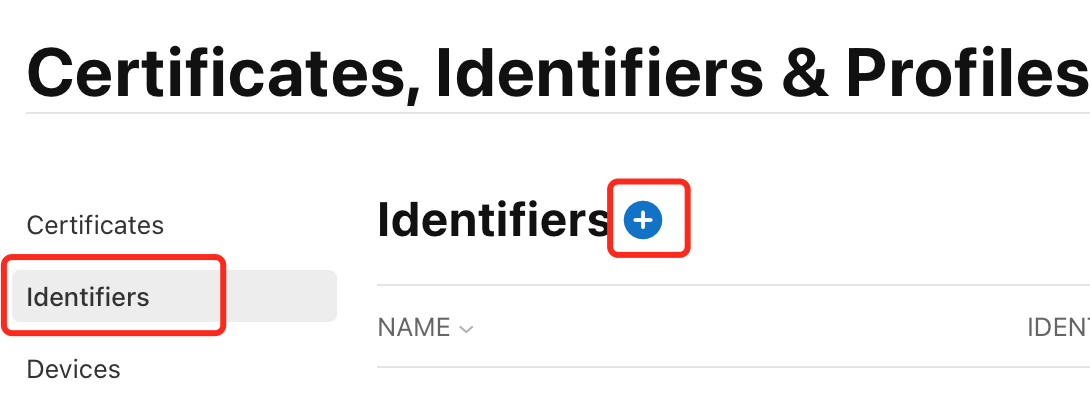
-
From the options list, select App IDs (App ID), then click Continue.
-
From the options, confirm that the App ID type is automatically selected, then click Continue.
-
In the Description field, enter the name or description of the App ID. Select Explicit App ID and enter the App's Bundle ID in the Bundle ID field.
The explicit App ID you enter here should match the Bundle ID entered in the Summary panel of the target in Xcode.
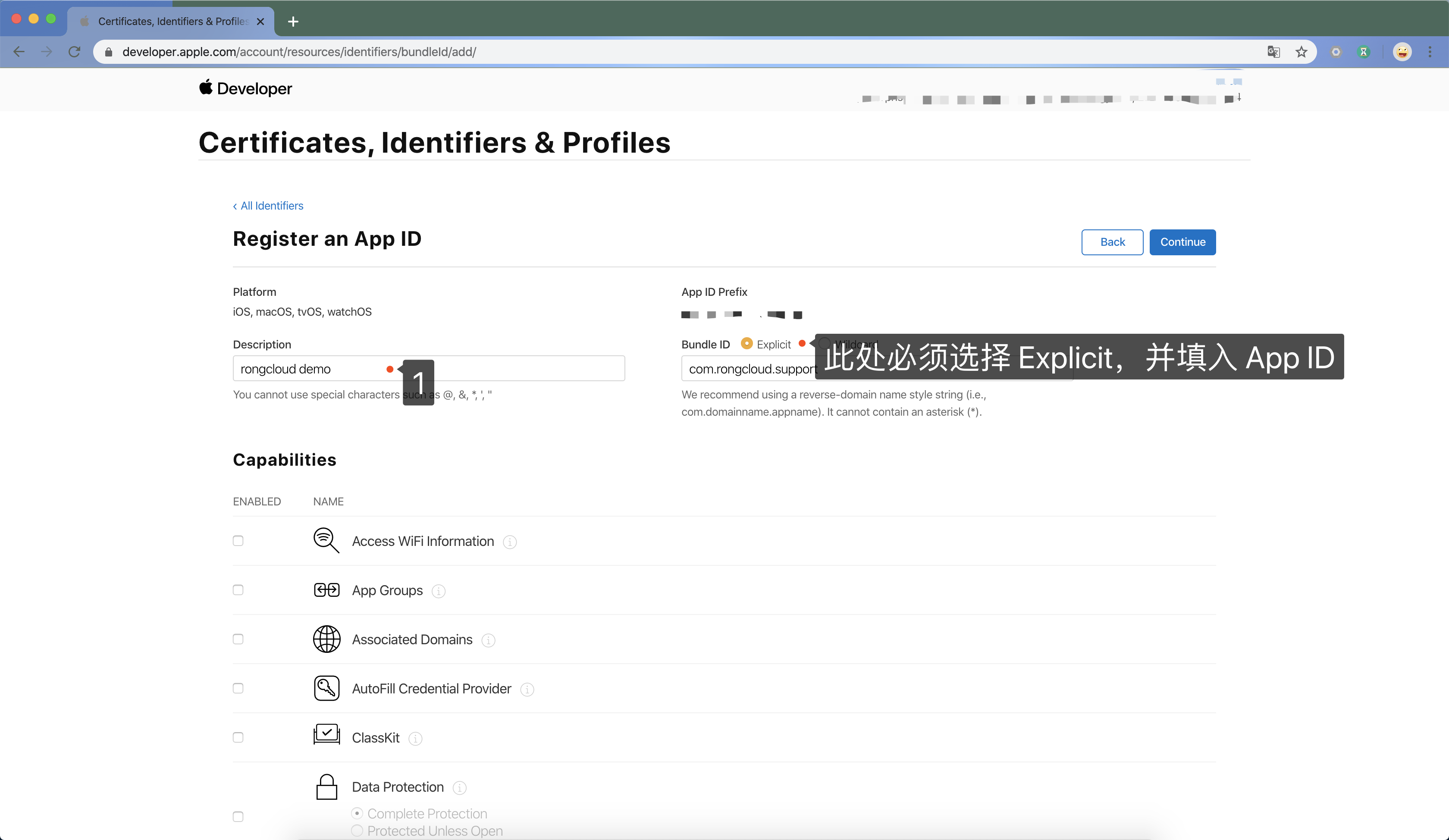
-
Under Capabilities, the App type and available features will be displayed. Check the corresponding checkboxes to enable the App features you want to use.
Check Push Notifications to enable the push notification feature.
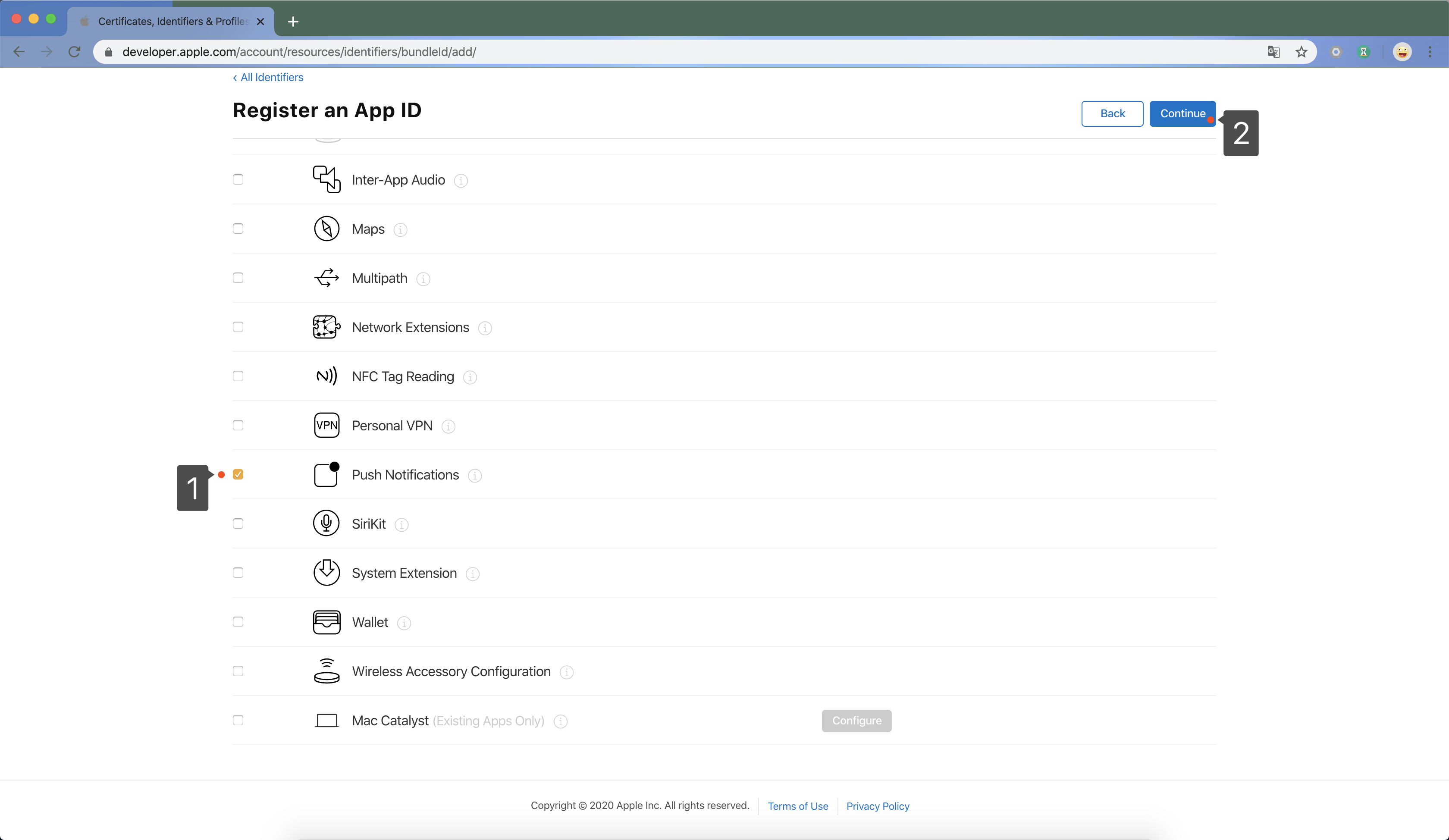
-
Click Continue, review the registration information, then click Register.
For detailed instructions on the above steps to create an App ID, refer to Apple Developer Account Help Documentation: Register an App ID.
Enabling Push Notifications for App ID
The following content is from Apple Developer Account Help Documentation: Enable Push Notifications.
The following steps describe how to enable push notifications for an existing App ID from the Apple Developer Account. If already enabled, skip this step.
-
In Certificates, Identifiers & Profiles (Certificates, Identifiers, and Profiles), click Identifiers in the sidebar, then find the corresponding App ID to configure.
-
Under Capabilities, check Push Notifications.

After enabling push notifications for the App ID, choose to create a P8 certificate or P12 certificate as needed.
Using Token Authentication (P8)
For more information on "Communicating with APNs using Token Authentication," refer to Apple Developer Documentation Establishing a Token-Based Connection to APNs. The following steps are from Apple Developer Account Help Documentation: Create and Download a Private Key Enabled for APNs.
You need to create and download a private key (.p8 text file, also known as "P8 certificate") for APNs push service from your Apple Developer account.
-
In Certificates, Identifiers & Profiles (Certificates, Identifiers, and Profiles), click Keys in the sidebar, then click the add button (+).
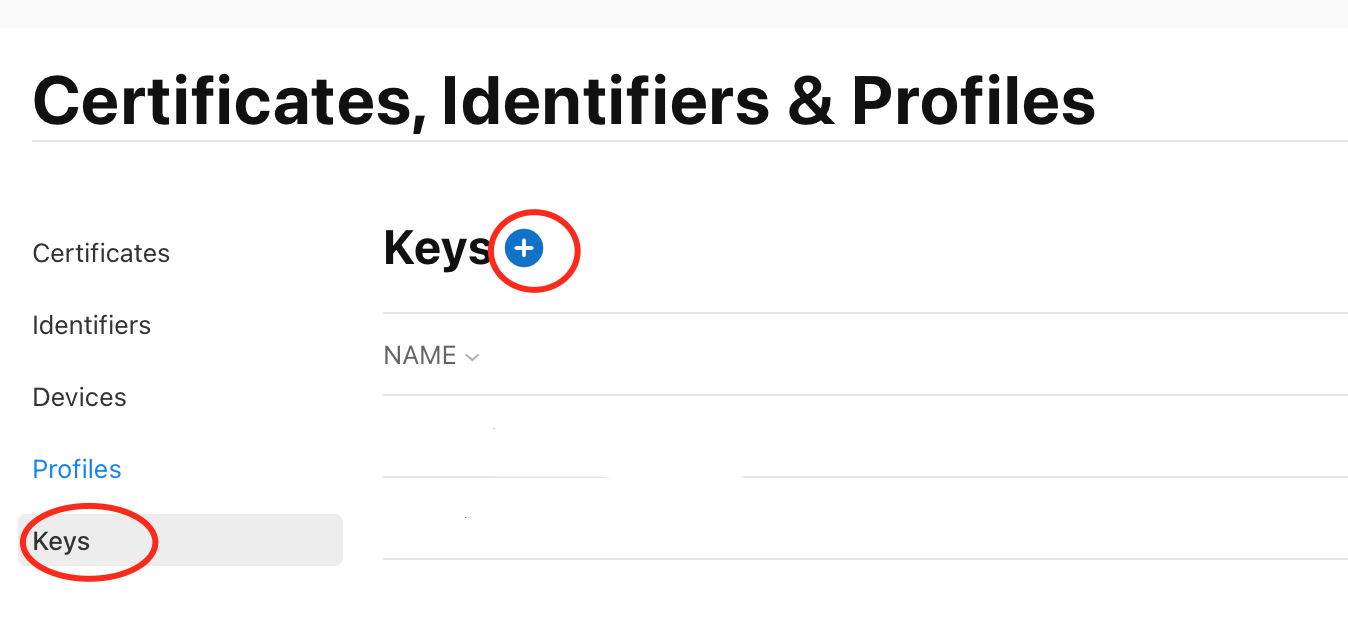
-
Under Key Name, enter a unique name for the key. Check Apple Push Notifications service (APNs) to enable APNs service, then click Continue.
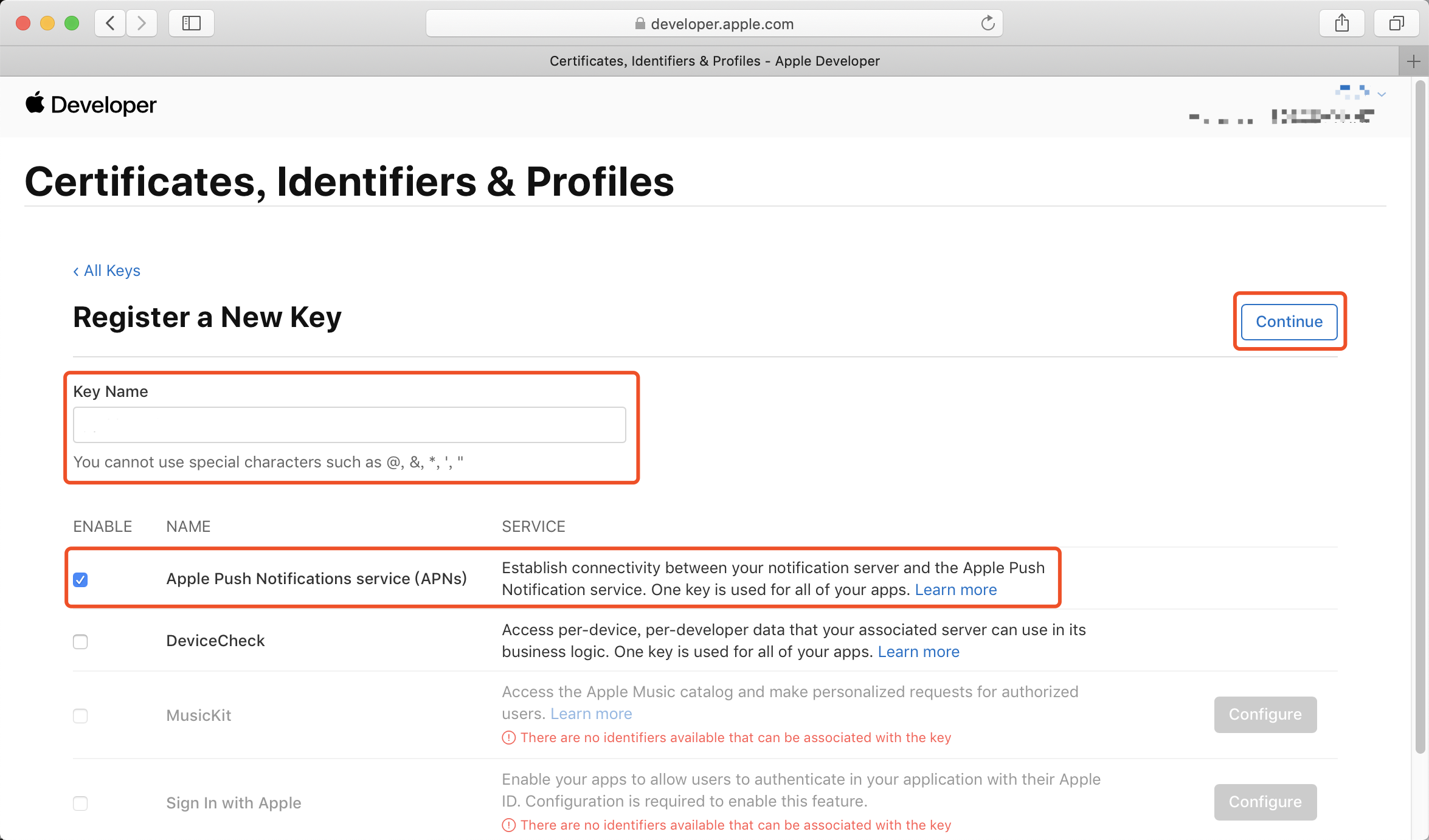
-
Review the key configuration, then click Confirm.
-
Click Download to immediately generate and download the key file. The key will be downloaded to your local machine as a text file with a
.p8extension.- Note: Please record the Key ID, as it will be needed later.
- Warning: The key can only be downloaded once. After downloading, it will be removed from your developer account, so be sure to keep it safe. If the Download button is disabled, it means you have already downloaded this key.
-
Click Done.
After obtaining the .p8 file, you can upload it to the RC Console. See Uploading Certificates to RC for details.
Using TSL Certificate (P12)
For more information on p12 certificates and "Communicating with APNs using TLS Certificates," refer to Apple Developer Documentation Establishing a Certificate-Based Connection to APNs.
Creating a p12 certificate requires first creating a Certificate Signing Request (CSR) locally, then uploading the CSR to the Apple Developer Account to generate a certificate (.cer) file, downloading it locally, and exporting it as a .p12 format certificate on a Mac.
Creating a Certificate Signing Request
The "Keychain Access" app on Mac allows you to create a Certificate Signing Request (CSR).
-
Open the Keychain Access app on Mac, select Certificate Assistant, then select Request a Certificate from a Certificate Authority.
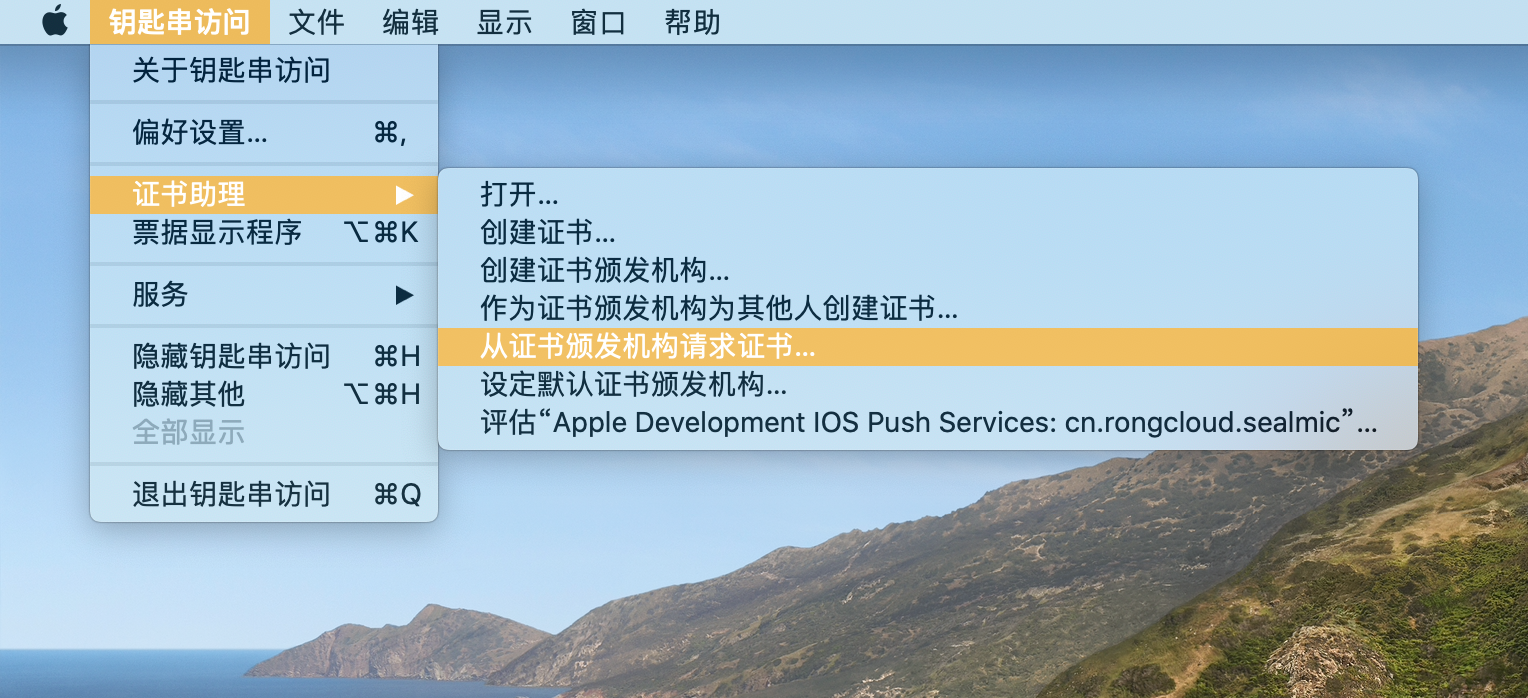
-
Fill in the certificate information and save it to disk.
- In the Certificate Assistant dialog, enter an email address in the "User Email Address" field.
- In the Common Name field, enter the name of the key (e.g., RC).
- Leave the CA Email Address field blank.
- Select Save to disk, then click Continue.
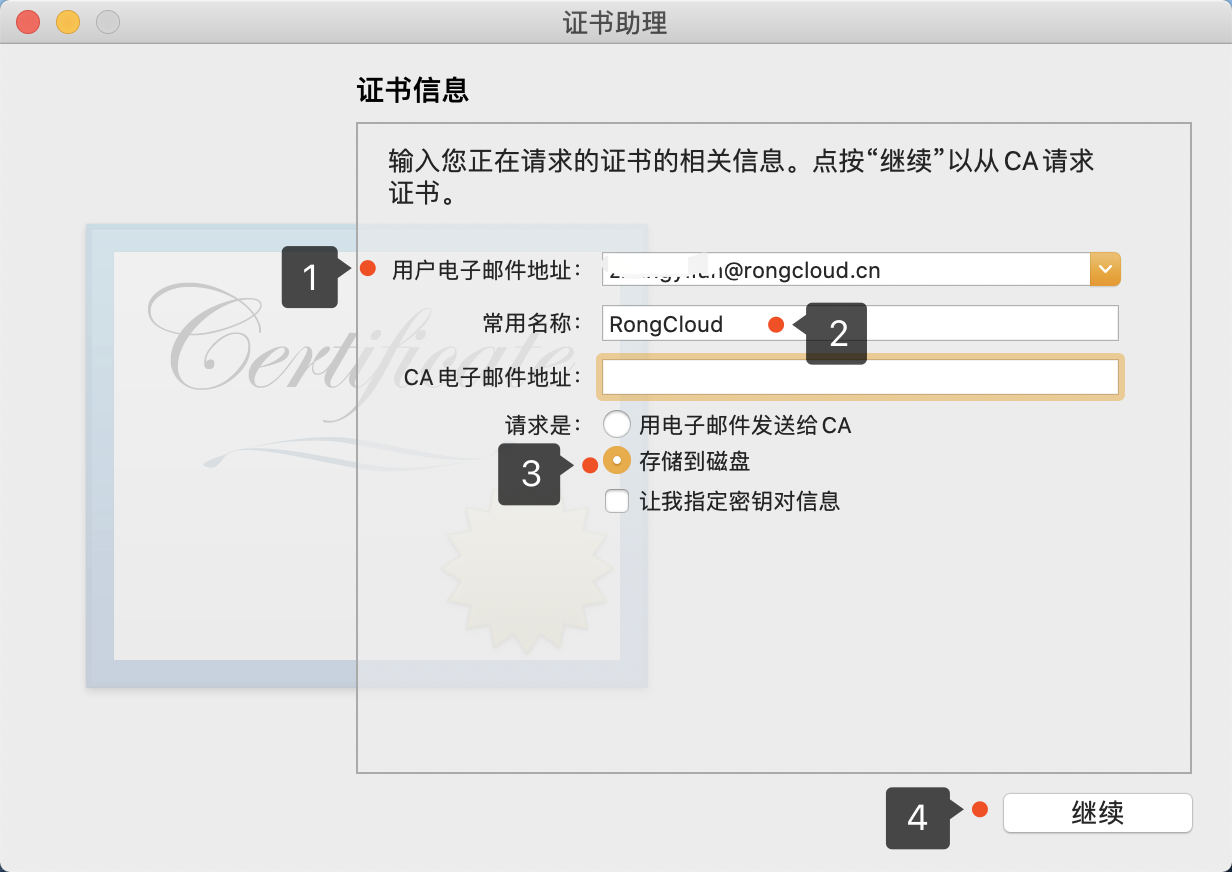
Generating a cer Format Certificate
If you have multiple Apps, you need to generate a separate client TLS certificate for each App.
This step describes how to generate a .cer format push certificate from the Apple Developer Account. Note that the .cer file created in this step must be converted to a .p12 format file before it can be uploaded to the RC Console.
The following two methods differ only in UI operations; either can be chosen.
-
Method 1: Generate the
.cerfile from the Certificates page of the Apple Developer Account.-
In Certificates, Identifiers & Profiles (Certificates, Identifiers, and Profiles), click Certificates in the sidebar, then click the add button (+).

-
Select the certificate type, then click Continue.
- Apple Push Notification service SSL (Sandbox): Can only push to the APNs Sandbox environment. Only this type of certificate can be used in the RC Console environment; production environment does not allow this type of certificate.
- Apple Push Notification service SSL (Sandbox & Production): Can push to both APNs Sandbox and Production environments, and can be used in both development and production environments of RC apps.
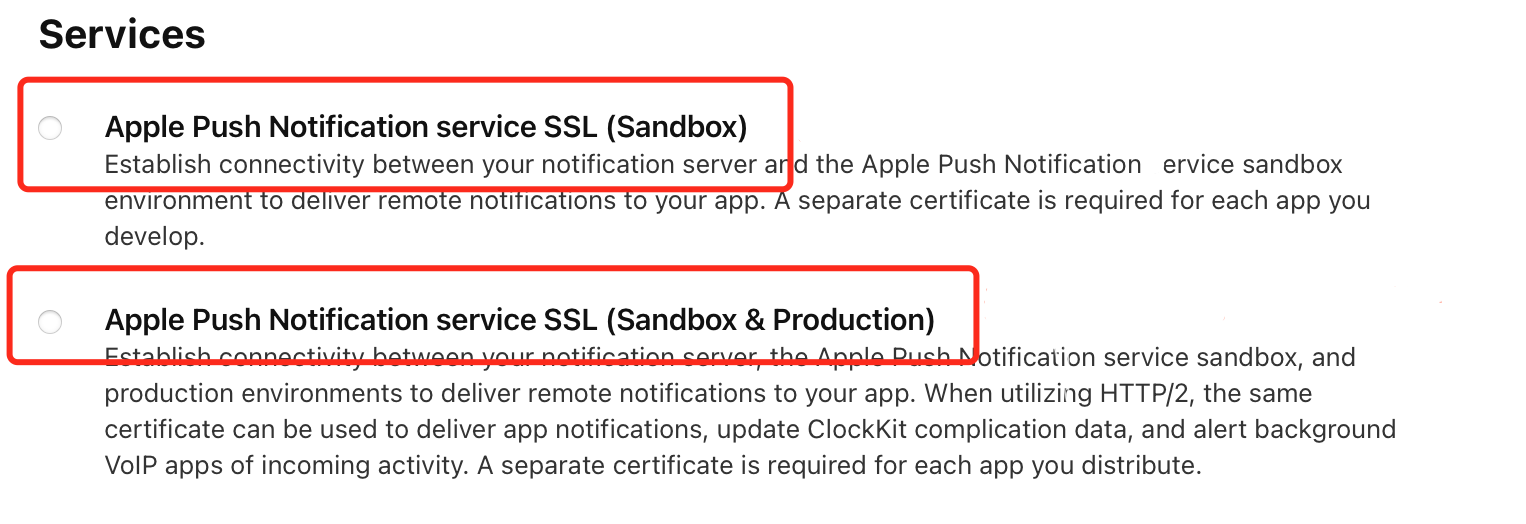
-
Select the App ID for which you want to generate the certificate, then click Continue.
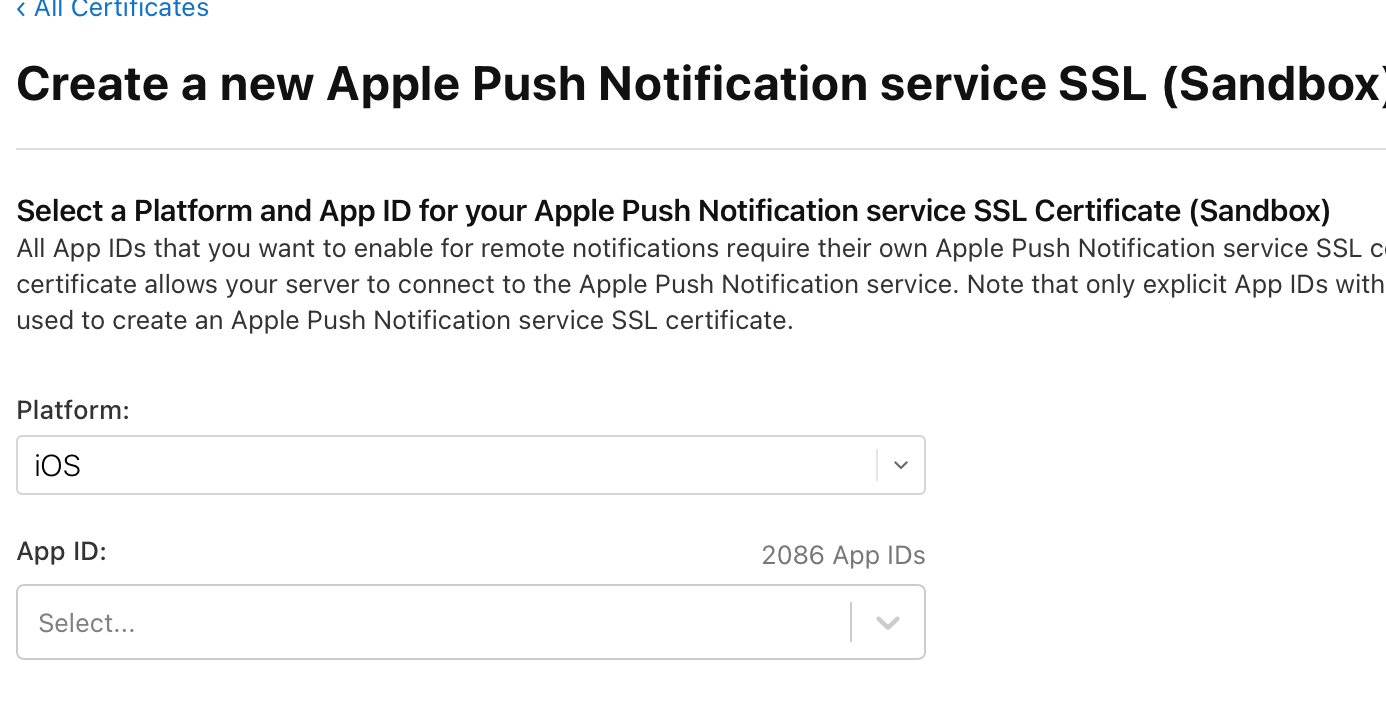
-
Create a Certificate Signing Request on Mac. If you have already created a CSR file as per the instructions above, skip this step.
-
Click Choose File, upload the generated CSR file, then click Continue.
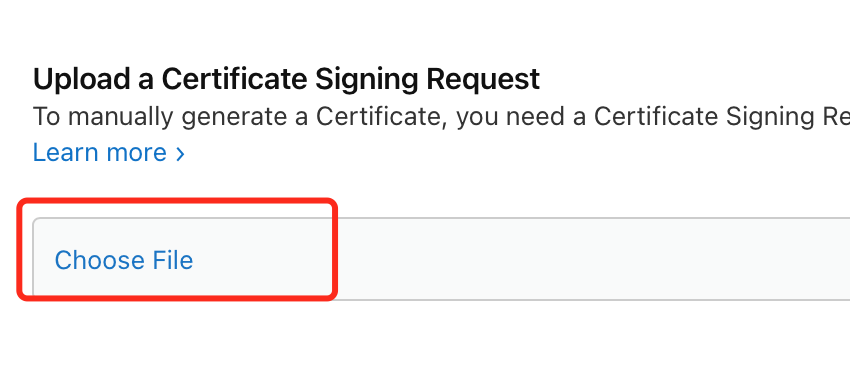
-
Click Download to download the certificate to your local machine.
-
-
Method 2: Generate the
.cerfile from the Identifiers page of the Apple Developer Account.tipThe following steps are from Apple Developer Account Help Documentation: Generate APNs Client TLS Certificate.
-
In Certificates, Identifiers & Profiles (Certificates, Identifiers, and Profiles), click Identifiers in the sidebar, then select the App ID you want to set up.
-
Under Capabilities, confirm that the Push Notifications checkbox is checked.
-
Click Configure to enter the certificate creation page. Select the environment for which you want to configure the certificate, then click Create Certificate. APNs provides two environments: production and development.
- Development SSL Certificate: Can only push to the APNs Sandbox environment. Only this type of certificate can be used in the RC Console environment; production environment does not allow this type of certificate.
- Production SSL Certificate: Can push to both APNs Sandbox and Production environments, and can be used in both development and production environments of RC apps.
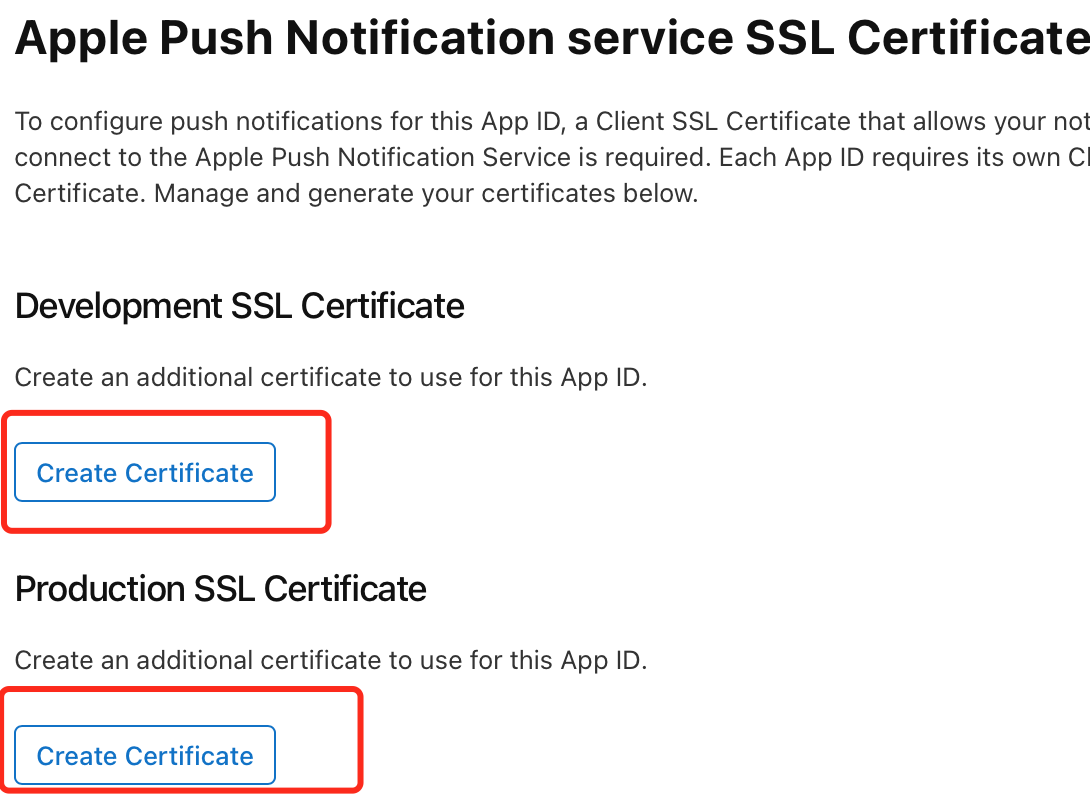
-
Create a Certificate Signing Request on Mac. If you have already created a CSR file as per the instructions above, skip this step.
-
Click Choose File, upload the generated CSR file, then click Continue.

-
Click Download to download the certificate to your local machine.
-
Converting cer File to P12 Format Certificate
-
Double-click the downloaded certificate file (
.cer), and the certificate will be automatically imported into the keychain. The certificate name will beApple [Development/Production] iOS Push Services: [Bundle ID]orApple Push Services: [Bundle ID]. -
In the Keychain Access app on Mac, click Login and Certificates on the left, select the newly imported certificate, right-click, and export it as a
.p12format certificate file.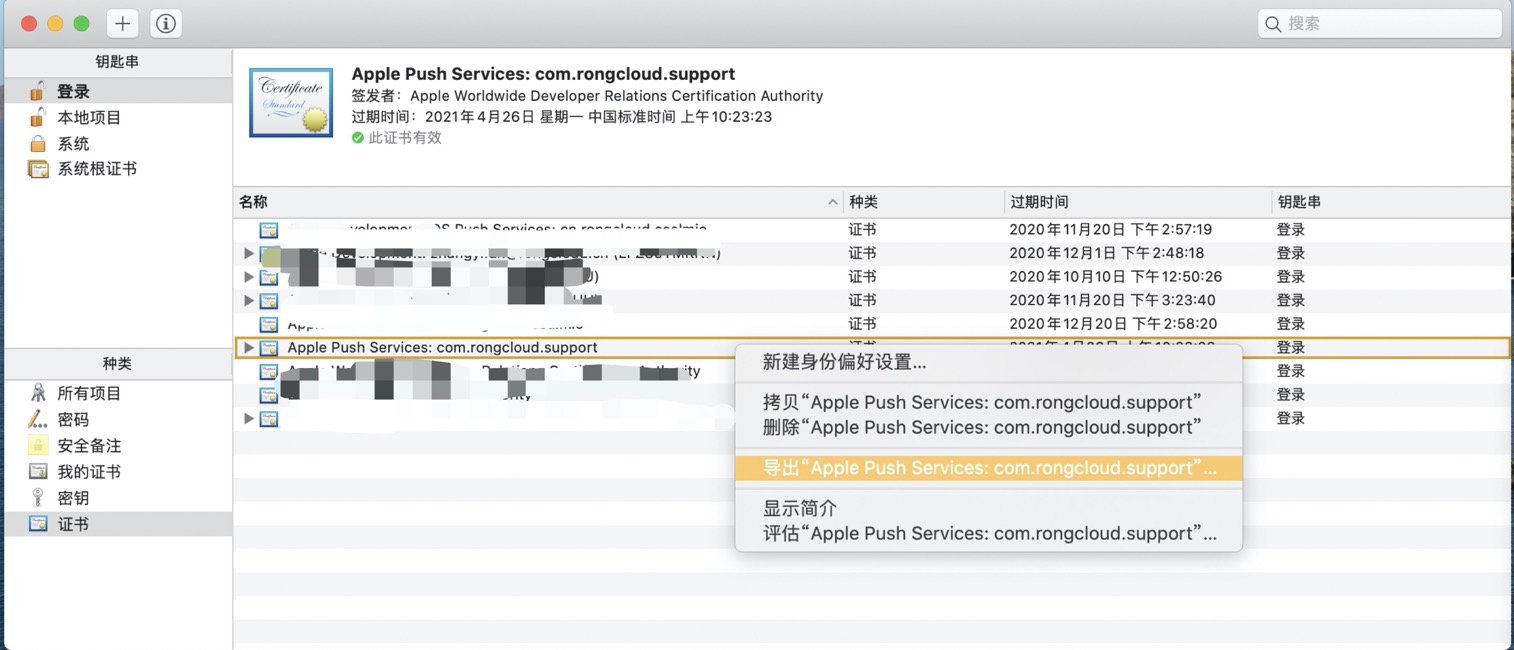
-
A dialog will appear, prompting you to enter a password to protect the exported item. The password you enter here will be used when uploading the p12 certificate to the RC backend, so be sure to record this password.
-
Enter the certificate password again to perform the export operation.
Configuring APNs Push in RC Console
You need to upload the created APNs Auth Key file (P8) or TSL certificate (P12) to the RC backend so that the RC server can communicate with APNs and send push notifications to iOS clients.
-
Go to the RC Console, click Application Identifier and find the project you want to integrate, then click Set Push. If not created, click Add.
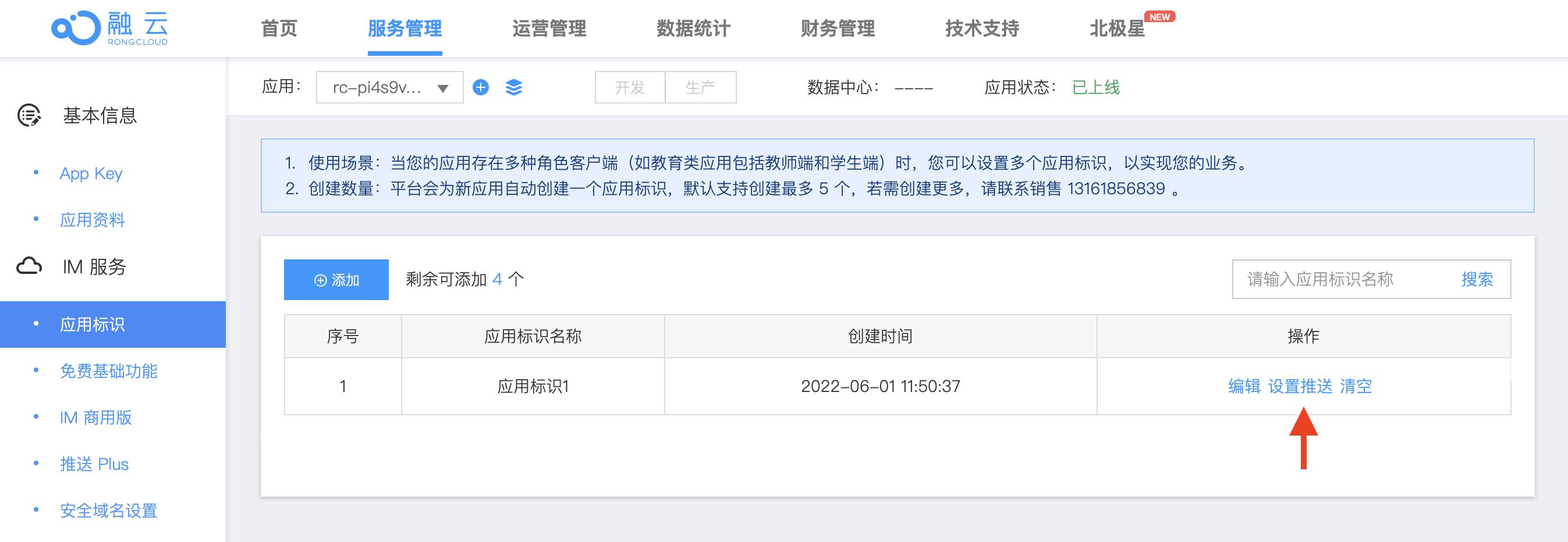
-
Fill in the Bundle Identifier.
-
If you created a P8 certificate file, select Token Authentication under Authentication Method. Follow these steps:
-
Click Upload P8 File, select the
.p8APNs signing key file you created.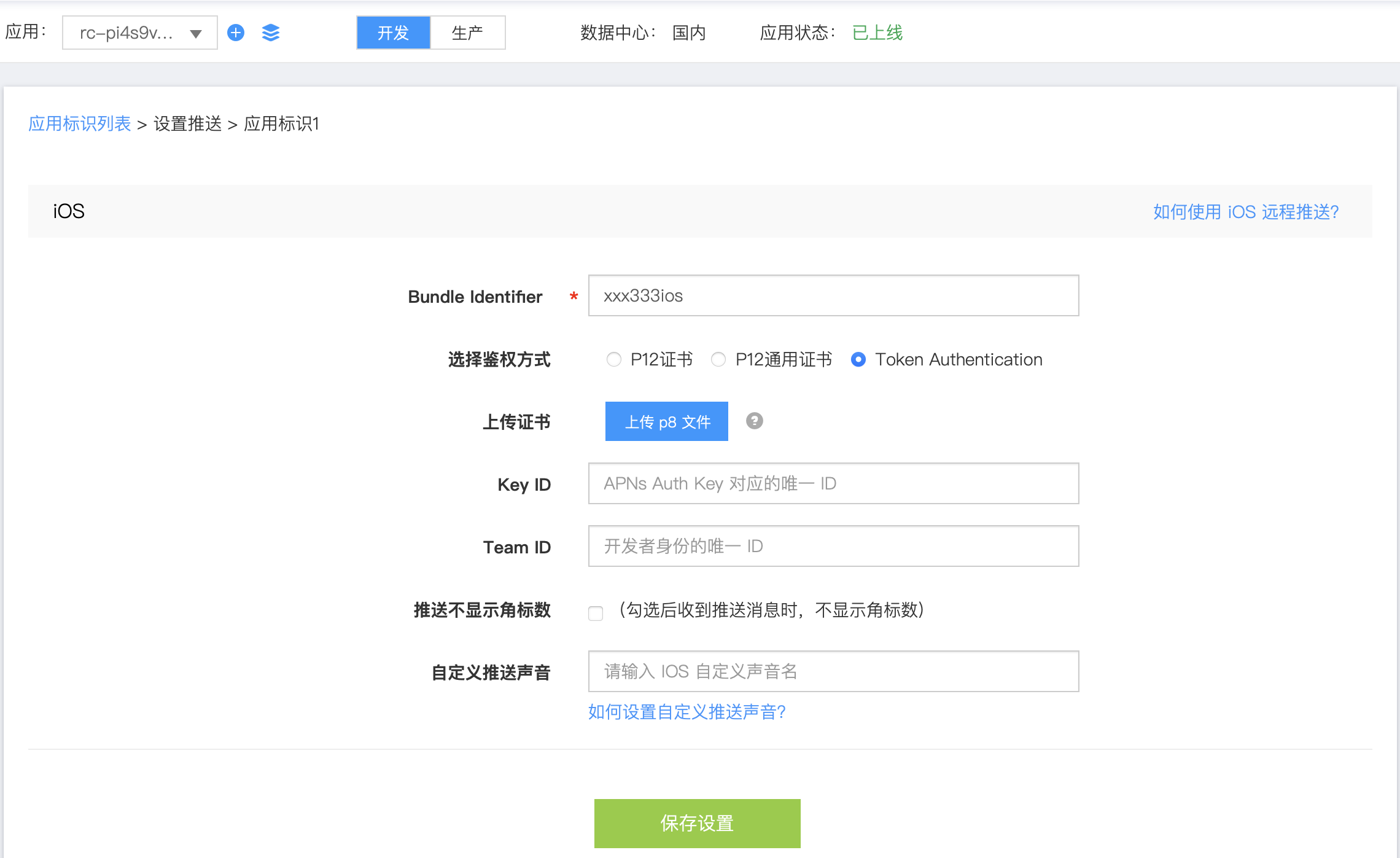
-
Fill in the Key ID (see Creating P8 Certificate).
-
Fill in the Team ID. You can obtain the Team ID from the Membership page of your Apple Developer Account.

-
-
If you created a P12 certificate file, note that the production environment of RC apps only accepts APNs universal certificates (Sandbox & Production). Choose the appropriate authentication method based on the certificate type and current environment:
- If uploading an APNs development certificate (Sandbox), select P12 Certificate.
- If uploading an APNs universal certificate (Sandbox & Production), select P12 Universal Certificate.
- Upload the certificate and enter the certificate password.
- If using the APNs universal certificate (Sandbox & Production) in the development environment of the RC app, select the push environment to APNs Sandbox or Production. When using the APNs universal certificate in the production environment, only pushing to the APNs Production environment is supported, and no selection is needed.
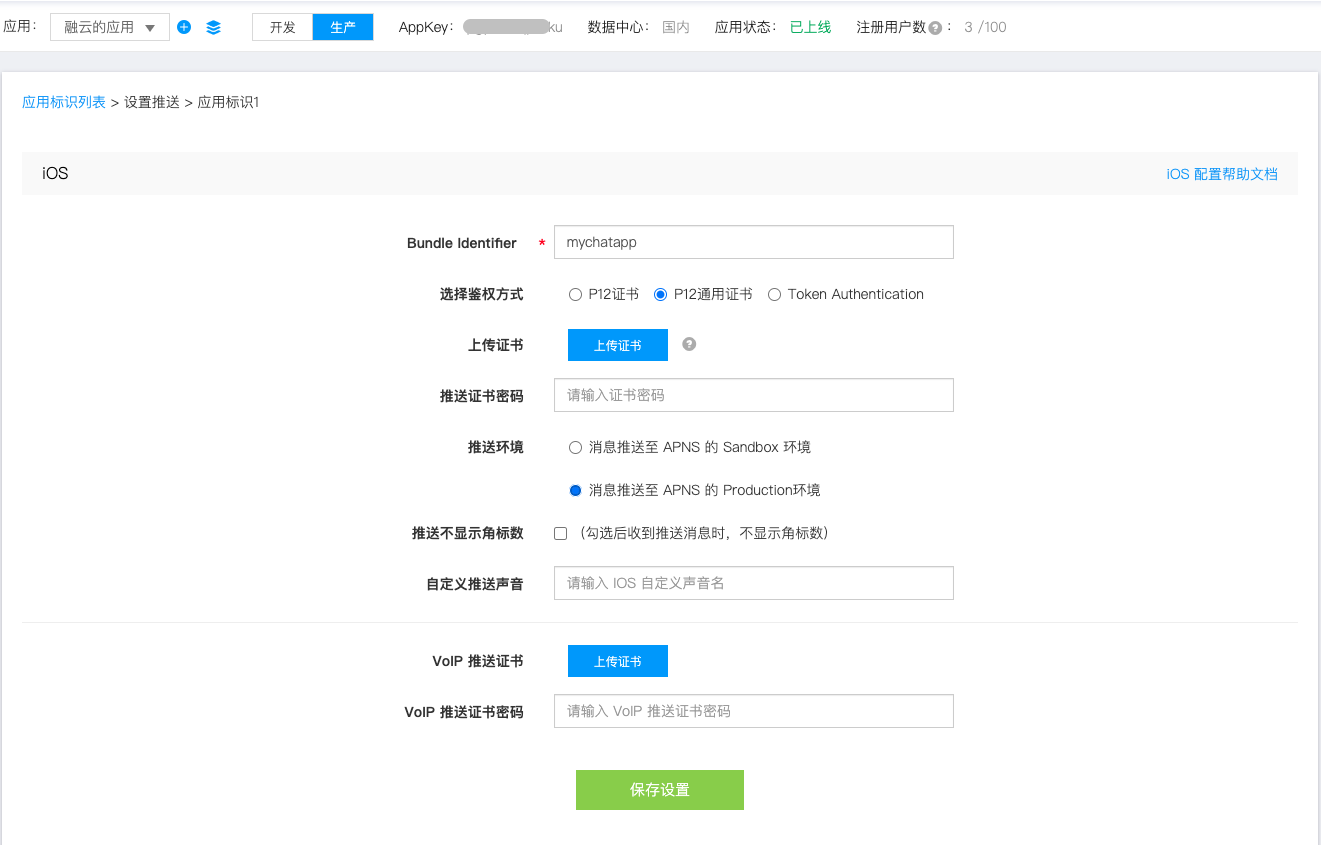
Creating a Provisioning Profile File
You need to create a Provisioning Profile (configuration file) to run your application on a device and use the push notification feature. You need to create and download a provisioning profile from the Apple Developer Account, then install the provisioning profile in Xcode.
-
In Certificates, Identifiers & Profiles (Certificates, Identifiers, and Profiles), click Profiles in the sidebar, then click the add button (+).
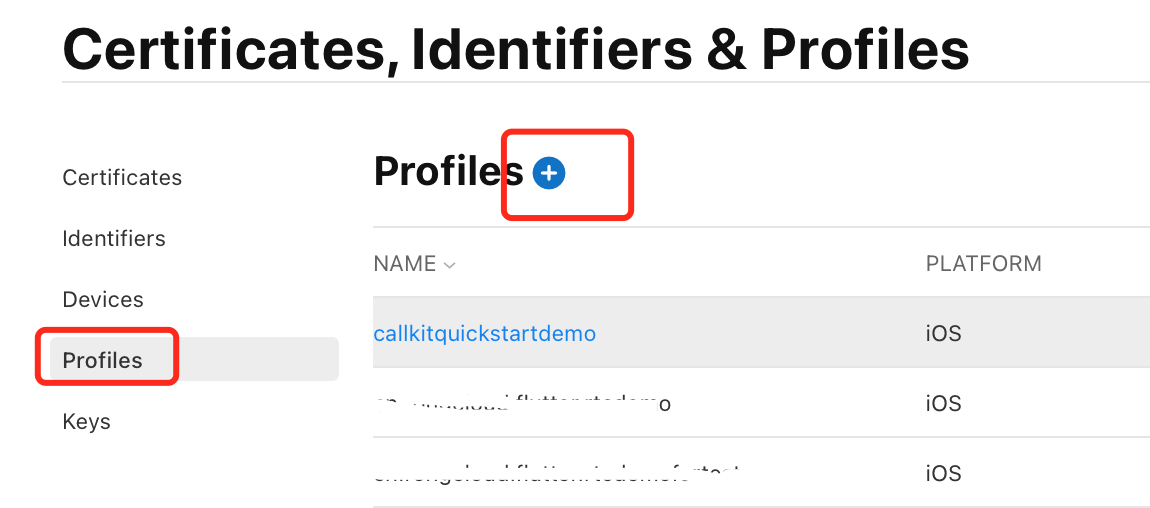
-
Select the environment for the Provisioning Profile, then click Continue.
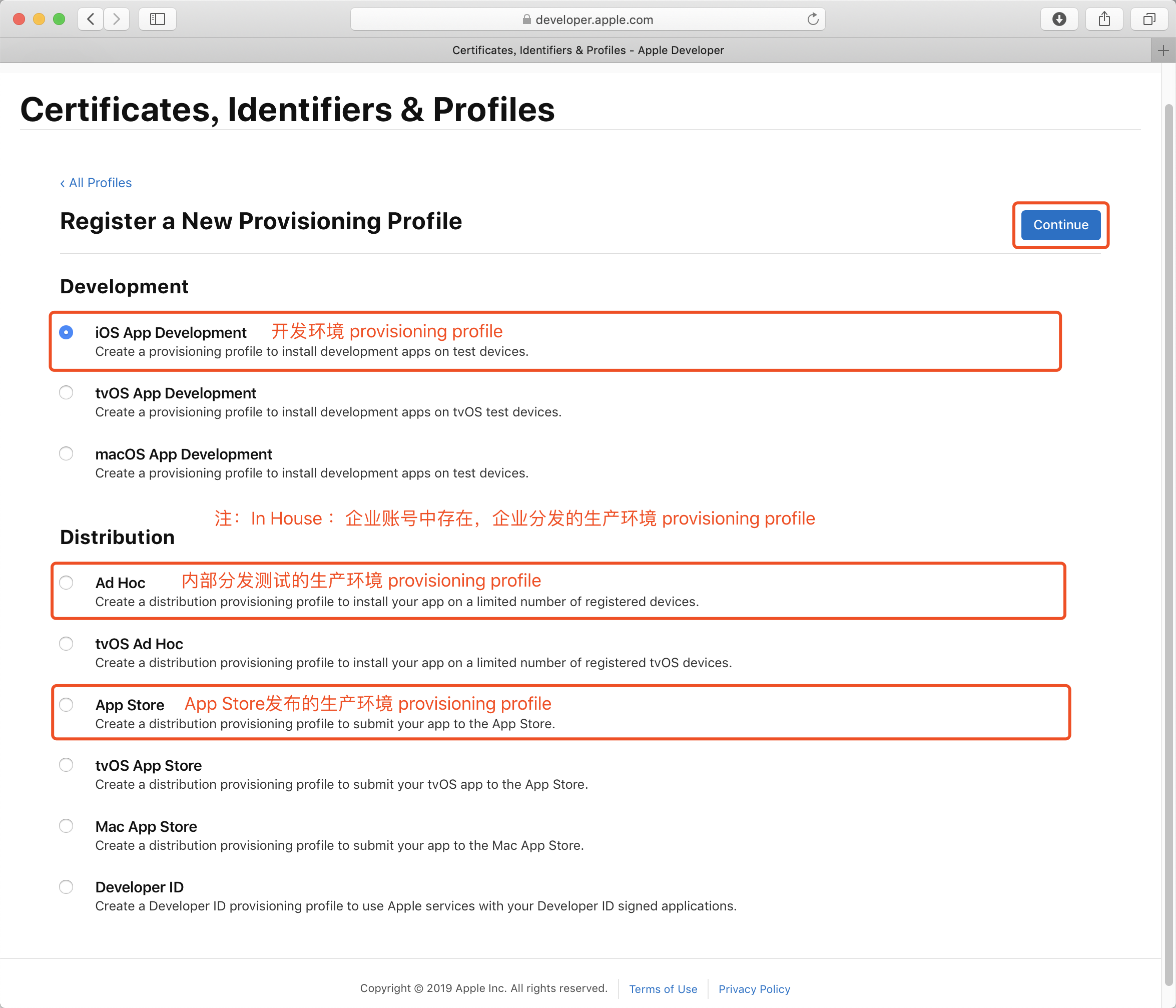
-
Select the App ID for which you want to create the Provisioning Profile, then click Continue.
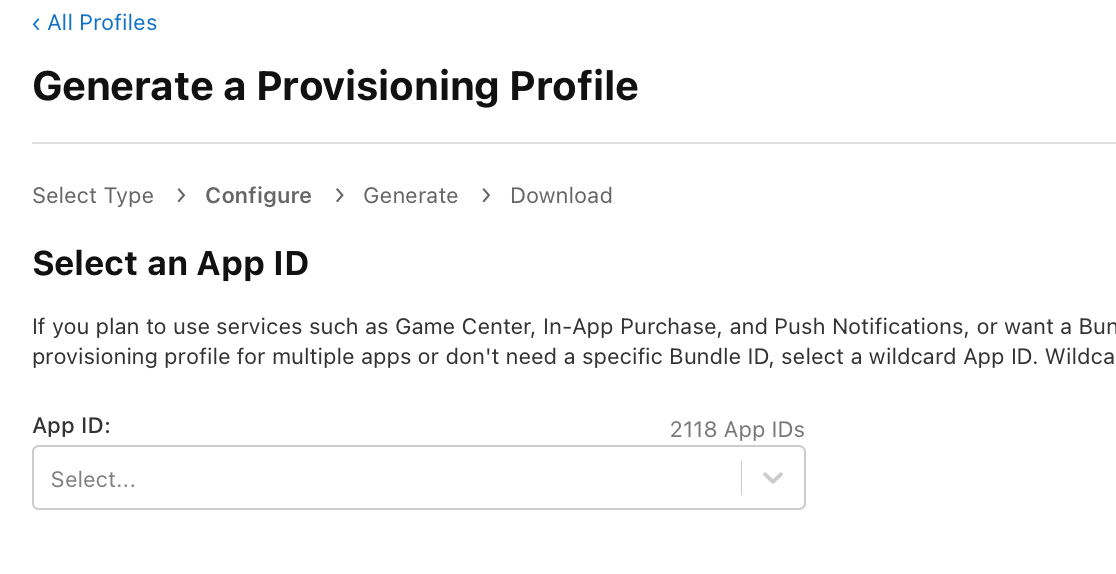
-
Select the developer certificate you belong to. If multiple certificates are created, select Select All, then click Continue.
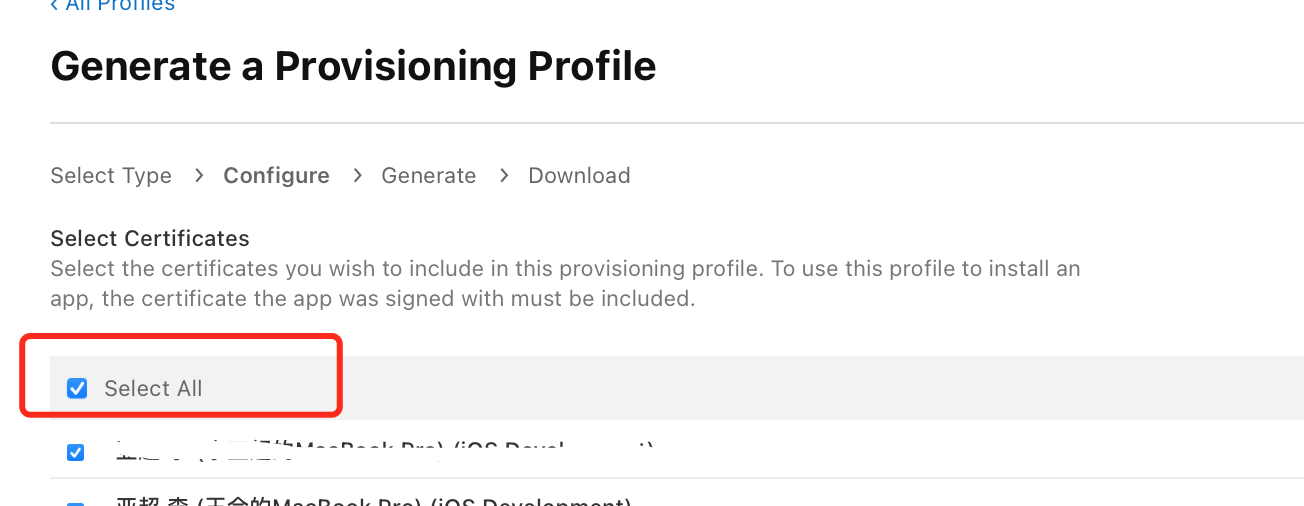
-
Select the devices to install this Provisioning Profile (generally select Select All), then click Continue.
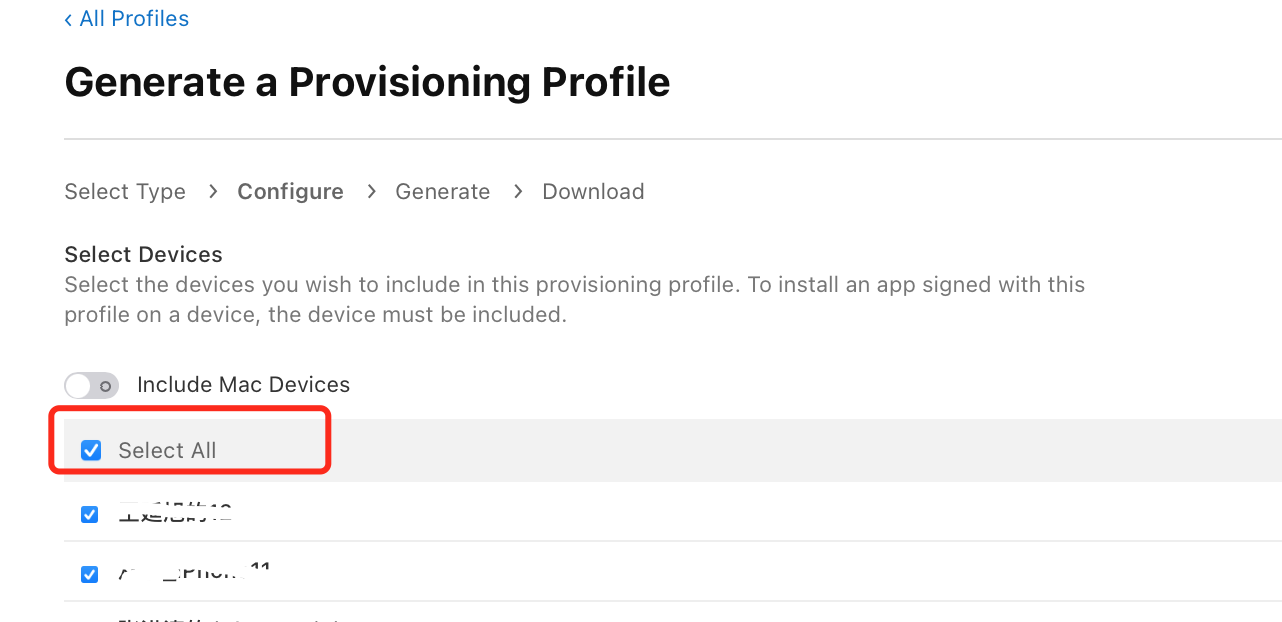
-
Fill in the Profile Name. It is recommended to name it Environment + AppID, then click Generate to complete the creation.
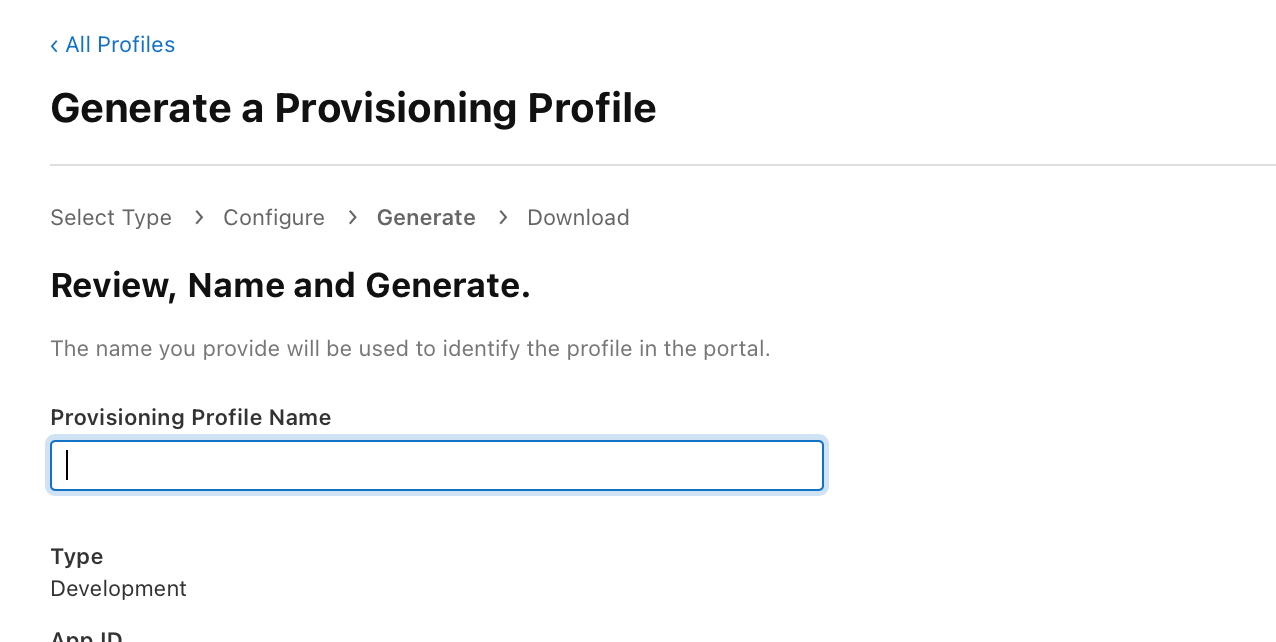
-
After creation, click Download to download it to your local machine.
-
Double-click the downloaded Provisioning Profile file to add it to Xcode.
Client Configuration
Requesting Push Permissions
Both local and remote pushes require permission to be requested.
- (BOOL)application:(UIApplication *)application didFinishLaunchingWithOptions:(NSDictionary *)launchOptions {
if ([[UIDevice currentDevice].systemVersion floatValue] >= 10.0) {
UNUserNotificationCenter *center = [UNUserNotificationCenter currentNotificationCenter];
center.delegate = self;
[center requestAuthorizationWithOptions:(UNAuthorizationOptionAlert | UNAuthorizationOptionBadge | UNAuthorizationOptionSound) completionHandler:^(BOOL granted, NSError * _Nullable error) {
if (granted) {
//Click Allow
[center getNotificationSettingsWithCompletionHandler:^(UNNotificationSettings * _Nonnull settings) {
}];
} else {
}
}];
}else if ([[UIDevice currentDevice].systemVersion floatValue] >8.0){
//iOS8 - iOS10
[application registerUserNotificationSettings:[UIUserNotificationSettings settingsForTypes:UIUserNotificationTypeAlert | UIUserNotificationTypeSound | UIUserNotificationTypeBadge categories:nil]];
}
}
After the user agrees, you also need to obtain the Device Token on the user’s device. The RC server can use this token to submit requests to the APNs Server, and APNs will identify the device and app through the token to push notifications to the user.
-
For iOS 10 and later, register with the APNs push service to obtain the Device Token:
// iOS 10 and later, register to get the Device Token
[application registerForRemoteNotifications]; -
For iOS 8-10, register with the APNs push service in the application:didRegisterUserNotificationSettings: callback to obtain the Device Token:
- (void)application:(UIApplication *)application didRegisterUserNotificationSettings:(UIUserNotificationSettings *)notificationSettings{
[application registerForRemoteNotifications];
}
Set Device Token
After the user’s device registers with the APNs push service, it will receive a Device Token of type NSData.
In the application:didRegisterForRemoteNotificationsWithDeviceToken: callback, provide this Device Token to RC via setDeviceTokenData.
- (void)application:(UIApplication *)application didRegisterForRemoteNotificationsWithDeviceToken:(NSData *)deviceToken {
[[RCIMClient sharedRCIMClient] setDeviceTokenData:deviceToken];
}
Retrieve Push Data
If your app needs to support iOS 7+, you can use the didReceiveRemoteNotification:fetchCompletionHandler: method to retrieve push data (userInfo).
On iOS 10 and later, you’ll need to use two delegate methods of UNUserNotificationCenterDelegate to retrieve notification information.
-
If the app is in the foreground, use userNotificationCenter:willPresentNotification:withCompletionHandler: to retrieve push data (
userInfo). -
When the app user clicks the notification, use userNotificationCenter:didReceiveNotificationResponse:withCompletionHandler: to retrieve push data (
userInfo)./// ios >= 10.0
#pragma mark - UNUserNotificationCenterDelegate
#if __IPHONE_OS_VERSION_MAX_ALLOWED >= __IPHONE_10_0
- (void)userNotificationCenter:(UNUserNotificationCenter *)center didReceiveNotificationResponse:(UNNotificationResponse *)response withCompletionHandler: # Integrate APNs Remote Push
RC's server has integrated APNs server functionality. When the app is terminated, suspended in the background, or remains in the background for more than 2 minutes, the SDK's long connection channel will disconnect. At this point, RC's server can notify the client through the APNs channel.
RC Server Support for APNs
RC's server supports the following verification methods with Apple's APNs server:
| Category | Differences | Required Credentials |
|---|---|---|
| Using Authentication Token (P8) | APNs processes token-based push requests faster. Apps under the same account can use the same P8 certificate, regardless of sandbox or production environments. P8 certificates are permanently valid. | You need to obtain a signing key (.p8 text file) from your Apple Developer account and provide it to RC. RC will use your key to sign the token in APNs push requests. |
| Using TSL Certificate (P12) | Must be bound to an Apple App ID and can only be used for that app. APNs certificates can support only the sandbox environment (P12 certificate) or both sandbox and production environments (P12 universal certificate). Valid for one year. | You can obtain this certificate from your Apple Developer account and provide it to RC. RC will use this certificate to authenticate with APNs. The certificate expires after one year, so be sure to create a new certificate before it expires and provide it to RC. |
The above content is excerpted from Apple's official developer documentation. For any questions, refer to the Apple Developer Account Help: Communicate with APNs Using Authentication Tokens and Communicate with APNs Using a TLS Certificate.
The following diagram illustrates the process of RC's offline messages triggering APNs push, using the TSL certificate as an example:

Apple Developer Account Operations
You must have an App ID to use APNs push services. The following describes how to create an App ID from the Apple Developer Account page and enable Push Notifications for the App ID.
Create an App ID
If you already have an App ID, skip this step and proceed directly to Enable Push for App ID.
The following steps describe how to create an App ID from the Apple Developer Account:
-
In Certificates, Identifiers & Profiles, click Identifiers in the sidebar, then click the add button (+) at the top left.

-
From the options list, select App IDs, then click Continue.
-
Confirm that the App ID type is automatically selected, then click Continue.
-
Enter the name or description of the App ID in the Description field. Select Explicit App ID and enter the app's Bundle ID in the Bundle ID field.
The exact App ID you enter here should match the Bundle ID entered in the Summary panel of the target in Xcode.

-
Under Capabilities, the app type and available features will be displayed. Check the appropriate boxes to enable the features you want to use.
Check Push Notifications to enable push notification functionality.

-
Click Continue, review the registration information, then click Register.
For detailed instructions on the above steps, refer to the Apple Developer Account Help documentation: Register an App ID.
Enable Push for App ID
The following content is from the Apple Developer Account Help Documentation: Enable Push Notifications.
The following steps describe how to enable push notifications for an existing App ID from the Apple Developer Account. If already enabled, skip this step.
-
In Certificates, Identifiers & Profiles, click Identifiers in the sidebar, then locate the corresponding App ID to configure.
-
Check Push Notifications under Capabilities.

After enabling push for the App ID, choose to create either a P8 certificate or a P12 certificate as needed.
Use Authentication Token (P8)
To learn about "Communicating with APNs Using Authentication Tokens," refer to the Apple Developer Documentation Establishing a Token-Based Connection to APNs. The following steps are from the Apple Developer Account Help Documentation: Create and Download an APNs-Enabled Private Key.
You need to create and download a private key (.p8 text file, also known as a "P8 certificate") for APNs push services from your Apple Developer account.
-
In Certificates, Identifiers & Profiles, click Keys in the sidebar, then click the add button (+) at the top left.

-
Under Key Name, enter a unique name for the key. Check Apple Push Notifications service (APNs) to enable APNs services, then click Continue.

-
Review the key configuration, then click Confirm.
-
Click Download to immediately generate and download the key file. The key will be downloaded as a
.p8text file.- Note: Record the Key ID, as it will be needed later.
- Warning: The key can only be downloaded once. After downloading, it will be removed from your developer account, so be sure to keep it safe. If the Download button is disabled, it means you have already downloaded this key.
-
Click Done.
After obtaining the .p8 file, you can upload it to the RC console. See Upload Certificate to RC.
Use TSL Certificate (P12)
To learn about P12 certificates and "Communicating with APNs Using a TLS Certificate," refer to the Apple Developer Documentation Establishing a Certificate-Based Connection to APNs.
Creating a P12 certificate requires first creating a Certificate Signing Request (CSR) locally, then uploading the CSR to the Apple Developer Account to generate a certificate (.cer) file, downloading it locally, and exporting it as a .p12 certificate on a Mac.
Create a Certificate Signing Request
The "Keychain Access" app on a Mac allows you to create a Certificate Signing Request (CSR).
-
Open the Keychain Access app on your Mac, select Certificate Assistant, then select Request a Certificate from a Certificate Authority.

-
Fill in the certificate information and save it to disk.
- In the Certificate Assistant dialog, enter your email address in the "User Email Address" field.
- In the Common Name field, enter the name of the key (e.g., RC).
- Leave the CA Email Address field blank.
- Select Save to Disk, then click Continue.

Generate a .cer Certificate
If you have multiple apps, you need to generate a separate client TLS certificate for each app.
This step describes how to generate a .cer push certificate from the Apple Developer Account. Note that the .cer file created in this step must be converted to a .p12 file before it can be uploaded to the RC console.
The following two methods differ only in UI operations; choose either one.
-
Method 1: Generate a
.cerfile from the Certificates page of the Apple Developer Account.-
In Certificates, Identifiers & Profiles, click Certificates in the sidebar, then click the add button (+) at the top left.

-
Select the certificate type, then click Continue.
- Apple Push Notification service SSL (Sandbox): Can only push to the APNs Sandbox environment. Only this type of certificate can be used in the RC console environment; production environments do not allow this type of certificate.
- Apple Push Notification service SSL (Sandbox & Production): Can push to both APNs Sandbox and Production environments and can be used in both development and production environments of RC apps.

-
Select the App ID for which you want to generate the certificate, then click Continue.

-
Create a Certificate Signing Request on your Mac. If you have already created a CSR file as described above, skip this step.
-
Click Choose File, upload the generated CSR file, then click Continue.

-
Click Download to download the certificate to your local machine.
-
-
Method 2: Generate a
.cerfile from the Identifiers page of the Apple Developer Account.tipThe following steps are from the Apple Developer Account Help Documentation: Generate an APNs Client TLS Certificate.
-
In Certificates, Identifiers & Profiles, click Identifiers in the sidebar, then select the App ID you want to set up.
-
Under Capabilities, confirm that Push Notifications is checked.
-
Click Configure to enter the certificate creation page. Select the environment for which you want to configure the certificate, then click Create Certificate. APNs provides two environments: production and development.
- Development SSL Certificate: Can only push to the APNs Sandbox environment. Only this type of certificate can be used in the RC console environment; production environments do not allow this type of certificate.
- Production SSL Certificate: Can push to both APNs Sandbox and Production environments and can be used in both development and production environments of RC apps.

-
Create a Certificate Signing Request on your Mac. If you have already created a CSR file as described above, skip this step.
-
Click Choose File, upload the generated CSR file, then click Continue.

-
Click Download to download the certificate to your local machine.
-
Convert .cer File to P12 Certificate
-
Double-click the downloaded certificate file (
.cer), and the certificate will automatically be imported into the keychain. The certificate name will beApple [Development/Production] iOS Push Services: [Bundle ID]orApple Push Services: [Bundle ID]. -
In the Keychain Access app on your Mac, click Login and Certificates on the left, select the newly imported certificate, right-click, and export it as a
.p12certificate file.
-
A dialog will appear prompting you to enter a password to protect the exported item. The password you enter here will be used when uploading the P12 certificate to the RC backend, so be sure to record it.
-
Enter the certificate password again to complete the export.
Configure APNs Push in the RC Console
You need to upload the created APNs Auth Key file (P8) or TSL certificate (P12) to the RC backend so that the RC server can communicate with APNs and send push notifications to iOS clients.
-
Go to the RC Console, click App Identifier, and locate the project you want to integrate, then click Set Push. If not created, click Add.

-
Fill in the Bundle Identifier.
-
If you created a P8 certificate file, select Token Authentication under Authentication Method. Follow these steps:
-
Click Upload P8 File and select the APNs signing key
.p8file you created.
-
Fill in the Key ID (see Create P8 Certificate).
-
Fill in the Team ID. You can obtain the Team ID from the Membership page of your Apple Developer Account.

-
-
If you created a P12 certificate file, note that the production environment of the RC app only accepts APNs universal certificates (Sandbox & Production). Choose the appropriate authentication method based on the certificate type and current environment:
- If uploading an APNs development certificate (Sandbox), select P12 Certificate.
- If uploading an APNs universal certificate (Sandbox & Production), select P12 Universal Certificate.
- Upload the certificate and enter the certificate password.
- If using an APNs universal certificate (Sandbox & Production) in the development environment of the RC app, select the APNs Sandbox or Production environment under Push Environment. When using an APNs universal certificate in the production environment, only the APNs Production environment is supported, and no selection is needed.

Create a Provisioning Profile File
You need to create a Provisioning Profile (configuration file) to run your app on a device and use push notification functionality. You need to create and download a provisioning profile from the Apple Developer Account, then install the provisioning profile in Xcode.
-
In Certificates, Identifiers & Profiles, click Profiles in the sidebar, then click the add button (+) at the top left.

-
Select the environment for the Provisioning Profile, then click Continue.

-
Select the App ID for which you want to create the Provisioning Profile, then click Continue.

-
Select the developer certificate to which it belongs. If multiple certificates are created, select Select All, then click Continue.

-
Select the devices on which the Provisioning Profile will be installed (generally select Select All), then click Continue.

-
Fill in the Profile Name. It is recommended to name it Environment + AppID, then click Generate to complete the creation.

-
After successful creation, click Download to download it to your local machine.
-
Double-click the downloaded Provisioning Profile file to add it to Xcode.
Client Configuration
Request Push Permissions
Both local and remote pushes require permission to be requested.
- (BOOL)application:(UIApplication *)application didFinishLaunchingWithOptions:(NSDictionary *)launchOptions {
if ([[UIDevice currentDevice].systemVersion floatValue] >= 10.0) {
UNUserNotificationCenter *center = [UNUserNotificationCenter currentNotificationCenter];
center.delegate = self;
[center requestAuthorizationWithOptions:(UNAuthorizationOptionAlert | UNAuthorizationOptionBadge | UNAuthorizationOptionSound) completionHandler:^(BOOL granted, NSError * _Nullable error) {
if (granted) {
// Click Allow
[center getNotificationSettingsWithCompletionHandler:^(UNNotificationSettings * _Nonnull settings) {
}];
} else {
}
}];
}else if ([[UIDevice currentDevice].systemVersion floatValue] >8.0){
// iOS8 - iOS10
[application registerUserNotificationSettings:[UIUserNotificationSettings settingsForTypes:UIUserNotificationTypeAlert | UIUserNotificationTypeSound | UIUserNotificationTypeBadge categories:nil]];
}
}
After the user agrees, you also need to obtain the device token on the user's device. The RC server can use this token to submit requests to Apple Push Notification's server, and APNs will identify the device and app through the token to push notifications to the user.
-
For iOS 10 and later, register with APNs push services to obtain the device token:
// iOS 10 and later, register to get device token
[application registerForRemoteNotifications]; -
For iOS 8-10, register with APNs push services in the application:didRegisterUserNotificationSettings: callback to obtain the device token:
- (void)application:(UIApplication *)application didRegisterUserNotificationSettings:(UIUserNotificationSettings *)notificationSettings{
[application registerForRemoteNotifications];
}
Set Device Token
After the user's device registers with APNs push services, an NSData type device token can be obtained.
In the application:didRegisterForRemoteNotificationsWithDeviceToken: callback, provide this device token to RC via setDeviceTokenData.
- (void)application:(UIApplication *)application didRegisterForRemoteNotificationsWithDeviceToken:(NSData *)deviceToken {
[[RCIMClient sharedRCIMClient] setDeviceTokenData:deviceToken];
}
Get Push Data
If the app needs to support iOS version 7+, you can use the didReceiveRemoteNotification:fetchCompletionHandler: method to get push data (userInfo).
On iOS 10 and later, you need to use two delegate methods of UNUserNotificationCenterDelegate to get notification information.
-
If the app is in the foreground, you can use userNotificationCenter:willPresentNotification:withCompletionHandler: to get push data (
userInfo). -
When the app user clicks the notification, you can use userNotificationCenter:didReceiveNotificationResponse:withCompletionHandler: to get push data (
userInfo)./// ios >= 10.0
#pragma mark - UNUserNotificationCenterDelegate
#if __IPHONE_OS_VERSION_MAX_ALLOWED >= __IPHONE_10_0
- (void)userNotificationCenter:(UNUserNotificationCenter *)center didReceiveNotificationResponse:(UNNotificationResponse *)response withCompletionHandler:(void(^)(void))completionHandler NS_AVAILABLE_IOS(10_0){
// userInfo is the content of the remote push
completionHandler();
}
#endif
If the app is frozen by the system when clicking a remote push in the notification bar, use the following method to get the data:
- (BOOL)application:(UIApplication *)application
didFinishLaunchingWithOptions:(NSDictionary *)launchOptions {
// Content of the remote push
NSDictionary *remoteNotificationUserInfo = launchOptions[UIApplicationLaunchOptionsRemoteNotificationKey];
...
return YES;
}
The app can get remote push data via getPushExtraFromLaunchOptions or getPushExtraFromRemoteNotification.
The format of RC message's remote push content is as follows:
{
"aps" :
{
"alert" : "You got your emails.",
"badge" : 1,
"sound" : "default"
},
"rc":{
"cType":"PR",
"fId":"2121",
"oName":"RC:TxtMsg",
"tId":"3232",
"rId":"3243",
"id":"5FSClm2gQ9V9BZ-kUZn58B",
"rc-dlt-identifier":"2FSClm2gQ9Q9BZ-kUZn54B"
},
"appData":"xxxx"
}
| Parameter | Type | Description |
|---|---|---|
| alert | String | Content displayed in the remote push. Built-in messages have default displays. If you are using a custom message, you need to set it when sending. Corresponds to the pushContent in the iOS message sending interface. |
| cType | String | Conversation type. PR (private chat), DS (discussion group), GRP (group), CS (customer service), SYS (system conversation), MC (in-app public service), MP (cross-app public service), PH (non-landing notification), UG (ultra group). |
| bId | String | Channel ID of the ultra group. Only ultra group messages' remote push content will carry this field. If the message does not belong to any channel, the bId field will be an empty string. |
| fId | String | User ID of the message sender. |
| oName | String | Message type. RC built-in message types (see Built-in Message Types for ObjectName) or custom message types. |
| tId | String | Target ID. |
| rId | String | User ID of the receiver. |
| id | String | Unique identifier of the current push message, corresponding to the msgUID in the message routing function. |
| rc-dlt-identifier | String | When sending a recall message push, this is the ID of the message to be recalled, corresponding to the msgUID in the message routing function. |
| appData | String | Additional information of the remote push, corresponding to the pushData in the iOS message sending interface. |
Customize Push Notifications
- To customize remote push content, provide pushContent when sending a message.
- To intercept and modify remote push content, the app needs to create a
Notification Service Extension. See Apple's official developer documentation Modifying Content in Newly Delivered Notifications. - To customize the display style of remote push notifications, the app needs to create a
Notification Content Extension. See Apple's official developer documentation Customizing the Appearance of Notifications.
Test APNs Remote Push
After completing APNs push integration, you can refer to Test APNs Remote Push for testing.